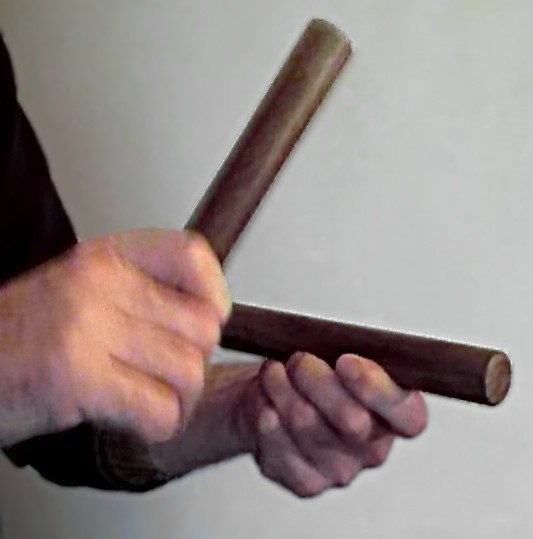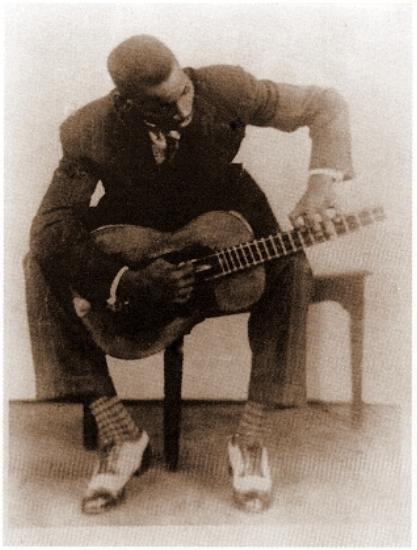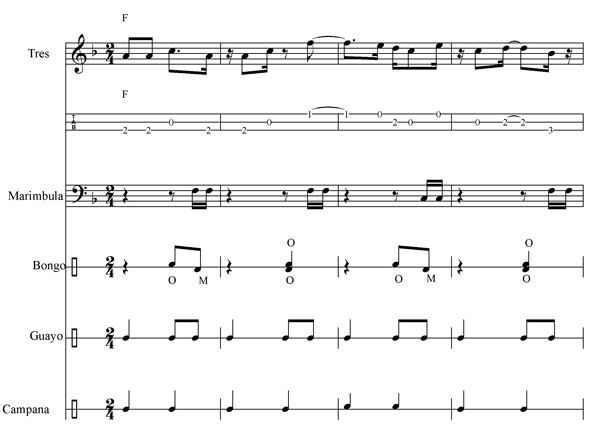|
Guajeo
A guajeo (Anglicized pronunciation: ''wa-hey-yo'') is a typical Cuban ostinato melody, most often consisting of arpeggiated chords in syncopated patterns. Some musicians only use the term ''guajeo'' for ostinato patterns played specifically by a tres, piano, an instrument of the violin family, or saxophones. Piano guajeos are one of the most recognizable elements of modern-day salsa. Piano guajeos are also known as ''montunos'' in North America, or '' tumbaos'' in the contemporary Cuban dance music timba. History The guajeo shares rhythmic, melodic and harmonic similarities with the short ostinato figures played on marimbas, lamellophones, and string instruments in sub-Saharan Africa. The guajeo is a seamless blend of African and European musical sensibilities, and was first played as accompaniment on the tres in the Afro-Cuban son and related music. The tres is a Cuban guitar-like instrument, consisting of three sets of double strings. Changüí The guajeo emerged in ... [...More Info...] [...Related Items...] OR: [Wikipedia] [Google] [Baidu] |
Clave Rhythm
The clave (; ) is a rhythmic pattern used as a tool for meter (music), temporal organization in Brazilian and Afro-Cuban music, Cuban music. In Spanish, ''clave'' literally means key, clef, code, or keystone. It is present in a variety of genres such as Abakuá music, Cuban rumba, rumba, conga (music), conga, son (music), son, mambo (music), mambo, Salsa music, salsa, songo music, songo, timba and Afro-Cuban jazz. The five-drum stroke, stroke clave pattern represents the structural core of many Cuban rhythms. The study of rhythmic methodology, especially in the context of Afro-Cuban jazz, Afro-Cuban music, and how it influences the Music and emotion, mood of a piece is known as clave theory. The clave pattern originated in sub-Saharan African music traditions, where it serves essentially the same function as it does in Cuba. In ethnomusicology, clave is also known as a ''key pattern'', ''guide pattern'', ''phrasing referent'', ''timeline'', or ''asymmetrical timeline''. The clav ... [...More Info...] [...Related Items...] OR: [Wikipedia] [Google] [Baidu] |
Ostinato
In music, an ostinato (; derived from the Italian word for ''stubborn'', compare English ''obstinate'') is a motif or phrase that persistently repeats in the same musical voice, frequently in the same pitch. Well-known ostinato-based pieces include classical compositions such as Ravel's ''Boléro'' and the '' Carol of the Bells'', and popular songs such as John Lennon’s “Mind Games” (1973), Donna Summer and Giorgio Moroder's " I Feel Love" (1977), Henry Mancini's theme from ''Peter Gunn'' (1959), The Who's " Baba O'Riley" (1971), The Verve's " Bitter Sweet Symphony" (1997), and Flo Rida's " Low" (2007). Both ''ostinatos'' and ''ostinati'' are accepted English plural forms, the latter reflecting the word's Italian etymology. The repeating idea may be a rhythmic pattern, part of a tune, or a complete melody in itself. Kamien, Roger (1258). ''Music: An Appreciation'', p. 611. . Strictly speaking, ostinati should have exact repetition, but in common usage, the term cover ... [...More Info...] [...Related Items...] OR: [Wikipedia] [Google] [Baidu] |
Tres Cubano
The tres (Spanish for ''three'') is a three-course chordophone of Cuban origin. The most widespread variety of the instrument is the original Cuban tres with six strings. Its sound has become a defining characteristic of the Cuban son and it is commonly played in a variety of Afro-Cuban genres. In the 1930s, the instrument was adapted into the Puerto Rican tres, which has nine strings and a body similar to that of the cuatro. The tres developed in the second half of the 19th century in the eastern region of Guantánamo, where it was used to play changüí, a precursor of son cubano. Its exact origins are not known, but it is assumed to have developed from the 19th century Spanish guitar, which it resembles in shape, as well as the laúd and bandola, two instruments used in punto cubano since at least the 18th century. Tres playing revolves around the ''guajeo'', an ''ostinato'' pattern found in many Afro-Cuban music styles. Tres players are commonly known as ''treseros'' (in Cu ... [...More Info...] [...Related Items...] OR: [Wikipedia] [Google] [Baidu] |
Tres (instrument)
The tres (Spanish language, Spanish for ''three'') is a three-Course (music), course chordophone of Cuban origin. The most widespread variety of the instrument is the original Cuban tres with six strings. Its sound has become a defining characteristic of the son cubano, Cuban son and it is commonly played in a variety of Afro-Cuban genres. In the 1930s, the instrument was adapted into the Puerto Rican tres, which has nine strings and a body similar to that of the Puerto Rican cuatro, cuatro. The tres developed in the second half of the 19th century in the eastern region of Guantánamo Province, Guantánamo, where it was used to play changüí, a precursor of son cubano. Its exact origins are not known, but it is assumed to have developed from the 19th century Classical guitar, Spanish guitar, which it resembles in shape, as well as the laúd and bandola, two instruments used in punto cubano since at least the 18th century. Tres playing revolves around the ''guajeo'', an ''ostinato ... [...More Info...] [...Related Items...] OR: [Wikipedia] [Google] [Baidu] |
Tres (musical Instrument)
The tres ( Spanish for ''three'') is a three- course chordophone of Cuban origin. The most widespread variety of the instrument is the original Cuban tres with six strings. Its sound has become a defining characteristic of the Cuban son and it is commonly played in a variety of Afro-Cuban genres. In the 1930s, the instrument was adapted into the Puerto Rican tres, which has nine strings and a body similar to that of the cuatro. The tres developed in the second half of the 19th century in the eastern region of Guantánamo, where it was used to play changüí, a precursor of son cubano. Its exact origins are not known, but it is assumed to have developed from the 19th century Spanish guitar, which it resembles in shape, as well as the laúd and bandola, two instruments used in punto cubano since at least the 18th century. Tres playing revolves around the ''guajeo'', an ''ostinato'' pattern found in many Afro-Cuban music styles. Tres players are commonly known as ''treseros'' (i ... [...More Info...] [...Related Items...] OR: [Wikipedia] [Google] [Baidu] |
Arsenio Rodríguez
Arsenio Rodríguez (born Ignacio Arsenio Travieso Scull; August 31, 1911 – December 30, 1970)Giro, Radamés 2007. ''Diccionario enciclopédico de la música en Cuba''. La Habana, v. 4, p. 45 et seq. was a Cuban musician, composer and bandleader. He played the Tres (musical instrument), tres, as well as the tumbadora, and he specialized in Son cubano, son, Cuban rumba, rumba and other Afro-Cuban music styles. In the 1940s and 1950s Rodríguez established the ''Conjunto#Cuban conjunto, conjunto'' format and contributed to the development of the son montuno, the basic template of modern-day salsa (music), salsa. He claimed to be the true creator of the Mambo (music), mambo and was an important as well as a prolific composer who wrote nearly two hundred songs. Despite being blind since the age of seven, Rodríguez quickly managed to become one of Cuba's foremost ''treseros''. His first hit, "Bruca maniguá" by Orquesta Casino de la Playa, came as a songwriter in 1937. For the f ... [...More Info...] [...Related Items...] OR: [Wikipedia] [Google] [Baidu] |
Tumbao
In music of Afro-Cuban origin, tumbao is the basic rhythm played on the bass. In North America, the basic conga drum pattern used in popular music is also called ''tumbao''. In the contemporary form of Cuban popular dance music known as timba, piano guajeos are known as ''tumbaos''. Bass pattern Clave-neutral The tresillo pattern is the rhythmic basis of the ostinato bass tumbao in Cuban son-based musics, such as son montuno, mambo, salsa, and Latin jazz. Often the last note of the measure is held over the downbeat of the next measure. In this way, only the two offbeats of tresillo are sounded. The first offbeat is known as ''bombo'', and the second offbeat (last note) is sometimes referred to as ''ponche''. The following example is written in cut-time (2/2). Clave-aligned Arsenio Rodríguez's group introduced bass tumbaos that have a specific alignment with clave. The 2-3 bass line of "Dame un cachito pa' huele" (1946) coincides with three of the clave's five strokes. D ... [...More Info...] [...Related Items...] OR: [Wikipedia] [Google] [Baidu] |
Changüí
''Changüí'' is a style of Cuban music which originated in the early 19th century in the eastern region of Guantánamo Province, specifically Baracoa. It arose in the sugar cane refineries and in the rural communities populated by slaves. ''Changüí'' combines the structure and elements of Spain's ''canción'' and the Spanish guitar with Africa Africa is the world's second-largest and second-most populous continent after Asia. At about 30.3 million km2 (11.7 million square miles) including adjacent islands, it covers 20% of Earth's land area and 6% of its total surfac ...n rhythms and percussion instruments of African origin. Changüí is considered a predecessor of '' son montuno'' (the ancestor of modern salsa), which has enjoyed tremendous popularity in Cuba throughout the 20th century. Changüí is related to the other regional genres of ''nengón'' and ''kiribá'' and is descended from ''nengón.'' Technically, the changüi ensemble consists of: ... [...More Info...] [...Related Items...] OR: [Wikipedia] [Google] [Baidu] |
Salsa (music)
Salsa music is a style of Latin American music, combining elements of Cuban and Puerto Rican influences. Because most of the basic musical components predate the labeling of salsa, there have been many controversies regarding its origin. Most songs considered as salsa are primarily based on son montuno and son cubano, with elements of cha-cha-chá, bolero, rumba, mambo, jazz, R&B, bomba, and plena. All of these elements are adapted to fit the basic Son montuno template when performed within the context of salsa. Originally the name salsa was used to label commercially several styles of Hispanic Caribbean music, but nowadays it is considered a musical style on its own and one of the staples of Hispanic American culture. The first self-identified salsa band is Cheo Marquetti y su Conjunto - Los Salseros which was formed in 1955. The first album to mention Salsa on its cover was titled “Salsa” which was released by La Sonora Habanera in 1957. Later on self-identified sal ... [...More Info...] [...Related Items...] OR: [Wikipedia] [Google] [Baidu] |
Montuno
Montuno has several meanings pertaining to Cuban music and its derivatives. Literally, ''montuno'' means 'comes from the mountain', and so '' son montuno'' may refer to the older type of son played in the mountainous rural areas of Oriente. Another possibility is that the word ''montuno'' comes from the word ''montura'', the Spanish word for "saddle", because the rhythm in son music is like riding a horse. Or it may mean the final section of a song-based composition; in this sense it is simply part of a piece of music. Here it is usually a faster, brasher, semi-improvised instrumental section, sometimes with a repetitive vocal refrain. Finally, the term ''montuno'' is also used for a piano '' guajeo'', the ostinato figure accompanying the montuno section, when it describes a repeated syncopated piano vamp, often with chromatic root movement.Orovio, Helio 2004. ''Cuban music from A to Z''. Tumi, Bath. p141 References See also *Call and response (music) In music, call ... [...More Info...] [...Related Items...] OR: [Wikipedia] [Google] [Baidu] |
Cuba
Cuba, officially the Republic of Cuba, is an island country, comprising the island of Cuba (largest island), Isla de la Juventud, and List of islands of Cuba, 4,195 islands, islets and cays surrounding the main island. It is located where the northern Caribbean Sea, Gulf of Mexico, and Atlantic Ocean meet. Cuba is located east of the Yucatán Peninsula (Mexico), south of both Florida and the Bahamas, west of Hispaniola (Haiti/Dominican Republic), and north of Jamaica and the Cayman Islands. Havana is the largest city and capital. Cuba is the List of countries and dependencies by population, third-most populous country in the Caribbean after Haiti and the Dominican Republic, with about 10 million inhabitants. It is the largest country in the Caribbean by area. The territory that is now Cuba was inhabited as early as the 4th millennium BC, with the Guanahatabey and Taino, Taíno peoples inhabiting the area at the time of Spanish colonization of the Americas, Spanish colonization ... [...More Info...] [...Related Items...] OR: [Wikipedia] [Google] [Baidu] |






